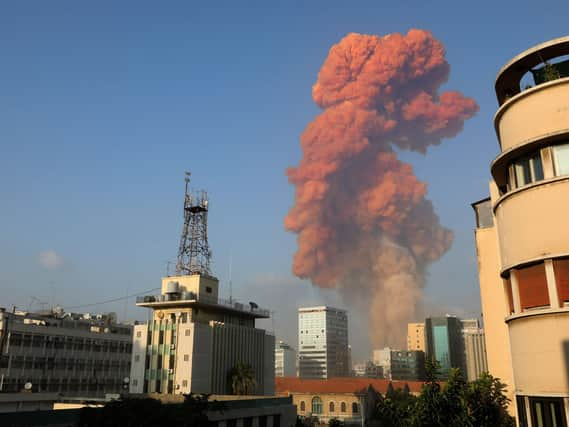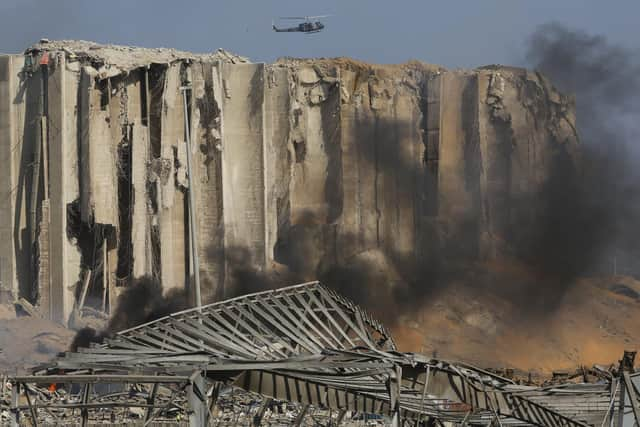Beirut explosion: This is how much energy the devastating blast unleashed


A team of disaster engineers from the University of Sheffield said the explosion was equivalent to between 500 and 1,100 tonnes of TNT, making it one of the largest non-nuclear blasts in history.
The university’s Blast and Impact Engineering Research Group made a detailed analysis of videos of the explosion posted on social media to estimate its power by tracking how the shockwave spread through the city.
Advertisement
Hide AdAdvertisement
Hide Ad

The engineers said they hope a more accurate assessment of the blast can be used to help with future disaster response planning, including by predicting the likely injuries and structural damage at various distances.
Sam Rigby, senior lecturer in blast and impact engineering, said: "The disaster that hit Beirut this summer was devastating and we hope that nothing like that ever happens again.
"This was an unprecedented event because never before has such a large explosion been so well documented.
"The reason why we decided to analyse the explosion is because as engineers it’s our jobs to use the skills and resources we have at our disposal to solve problems and ultimately to help people."
Advertisement
Hide AdAdvertisement
Hide AdThe huge blast on August 4, killed almost 200 people and left thousands injured when 2,750 tonnes of ammonium nitrate detonated, devastating a large swathe of the city.
The analysis, published in the journal Shock Waves, found that the explosion was around a 20th of the size of the atomic bomb used on Hiroshima in August 1945.
It found that the explosion released - in just milliseconds - the equivalent of around 1GWh (gigawatt hour) of energy. This is equal to the hourly energy generated by three million solar panels or 400 wind turbines.
Videos of the initial fire, detonation and blast wave were quickly shared on social media and enabled the team to determine the time of arrival of the shock front at different distances from the source of the explosion.
Advertisement
Hide AdAdvertisement
Hide AdThey analysed 16 videos with a clear line of sight to the explosion to time the arrival of the blast at 38 positions.
Dr Rigby said: "After seeing the events unfold, we wanted to use our expertise in blast engineering to help understand what had happened in Beirut and provide data that could be used to help prepare for and save lives in such events should they ever happen again.
"By understanding more about the power of large-scale accidental explosions like the one that occurred in Beirut, we can develop more accurate predictions of how different buildings will be affected, and the types of injuries there are likely to be at different distances from the blast."
Beirut explosion - chain of events
Shortly after 18:00 (15:00 GMT), on August 4, the roof of Warehouse 12, at the Port of Beirut, caught alight and there was a large initial explosion, followed by a series of smaller blasts.
Advertisement
Hide AdAdvertisement
Hide AdShortly after, there was an explosion that sent a mushroom cloud into the air and a supersonic blast wave radiating through the city.
That blast wave levelled buildings near the port and caused extensive damage over much of the rest of the capital, which is home to two million people.
The blast destroyed the immediate dockside area, creating a crater approximately 140m (460ft) wide, which flooded with seawater.
The warehouse where the initial fire and explosions were observed was obliterated and an adjacent grain silo was heavily damaged.
Advertisement
Hide AdAdvertisement
Hide AdBeirut Governor Marwan Abboud said as many as 300,000 people had been made temporarily homeless and that collective losses might reach $10-15bn (£8-11bn).
The blast was heard as far away as Cyprus, about 200km across the Mediterranean Sea, and seismologists at the United States Geological Survey said it was the equivalent of a 3.3-magnitude earthquake.
President Michel Naim Aoun declared a three-day mourning period following the devastating explosion in Bierut and since the Lebanese government resigned amid growing public anger.
____________________________
Support The Yorkshire Post and become a subscriber today.Your subscription will help us to continue to bring quality news to the people of Yorkshire. In return, you'll see fewer ads on site, get free access to our app and receive exclusive members-only offers.
Advertisement
Hide AdAdvertisement
Hide AdSo, please - if you can - pay for our work. Just £5 per month is the starting point. If you think that which we are trying to achieve is worth more, you can pay us what you think we are worth. By doing so, you will be investing in something that is becoming increasingly rare. Independent journalism that cares less about right and left and more about right and wrong. Journalism you can trust.
Thank you
James Mitchinson
Comment Guidelines
National World encourages reader discussion on our stories. User feedback, insights and back-and-forth exchanges add a rich layer of context to reporting. Please review our Community Guidelines before commenting.